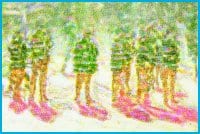With his latest work, POV, Stephen Andrews takes current political events and both abstracts and illuminates on their original meaning. POV consists of drawings and video that reflect and use one another. The photo-based drawings in the main space have the high pixilation and sun-drenched colours reminiscent of French Impressionism. They are smaller pieces and are what Andrews calls “large pictures in small format.” Because Andrews uses current media as his subject, he says, “The whole world is shoe-horned into a picture and the whole picture is shoe-horned into a small space.”
The subjects Andrews tackles come from what he calls “virtual or ether” media, in other words, cyberspace – this creates a fascinating dialogue between truth and illusion. The information we are inundated with on a daily basis can never be fully grasped because, as Andrews says, “facts change based on propaganda or media manipulation.” Like ether, the vapour of media only momentarily affects us before it dissipates and becomes undetectable. The technical aspect to Andrews’ works is such that the pixilation or dot matrix completely obscures details, making specifics impossible to see. We can’t grasp the full picture. This inability to fully distinguish what is happening in the drawings mirrors the political milieu on which Andrews comments.
POV looks directly into the eye of the beast by using very recent news footage, such as the London bombings. In essence, Andrews manipulates what has already been manipulated. Yet, unlike the news sources he works from, he wants to show us that narratives and stories are in fact interchangeable. Andrews asks viewers to be cognizant and critical. His primary investigation in this body of work is “in how meaning is constructed… like a study in adaptation.”
Upstairs in the gallery is a video animation produced in collaboration with Andrews’ partner John Greyson. The video uses the images from the main gallery as backdrop to discuss and disseminate fact and fiction. The video is edited into four stories that melt and pull apart from each other creating layer after layer of overlapping meaning. The pixilated images become exaggerated digital representations that appear like fascinating molecular structures. The pictures flash with repetition and are continuously reinterpreted by the editing and music. The aesthetics of the video indulges us with a deadly combination of smarts and beauty. Yet our indulgences are intentionally interrupted by a frustrating tug, specifics become further expunged by the video projection.
Andrews challenges viewers by honestly asking himself, “Where is the truth, if there is such a thing?” We experience media fabrication through Andrews and Greyson’s mediated version and critique. The accompanying music by Andrew Zealley is atmospheric and disarmingly mysterious; it is a highly sophisticated Chris Mark soundtrack (think X-Files theme but smarter).
The unabashed colours of bright blues, yellows and reds in POV create astonishingly pretty pictures. Yet Andrews’ interpellation of dictated falsehoods and right-wing agendas is both subtle and remarkably frank.

 Why you can trust Xtra
Why you can trust Xtra


